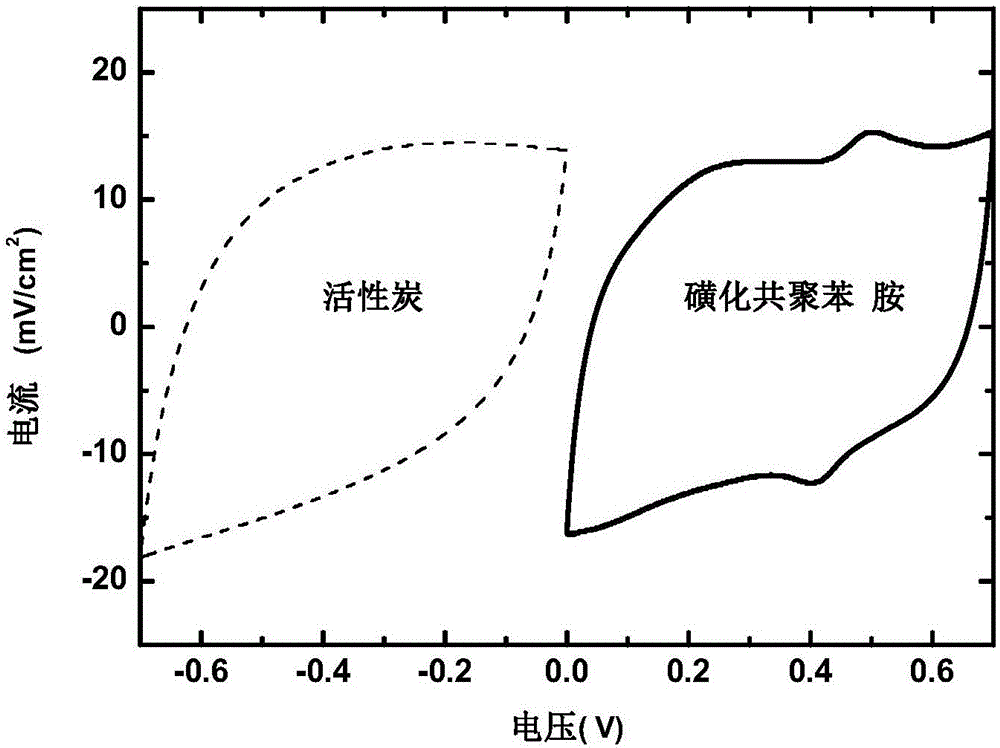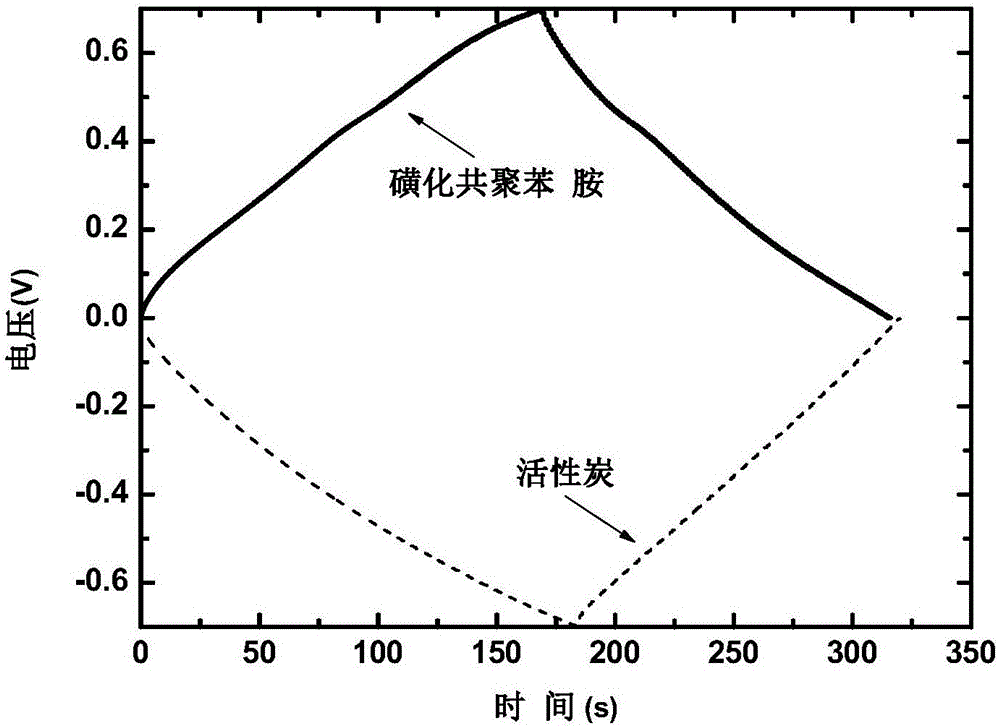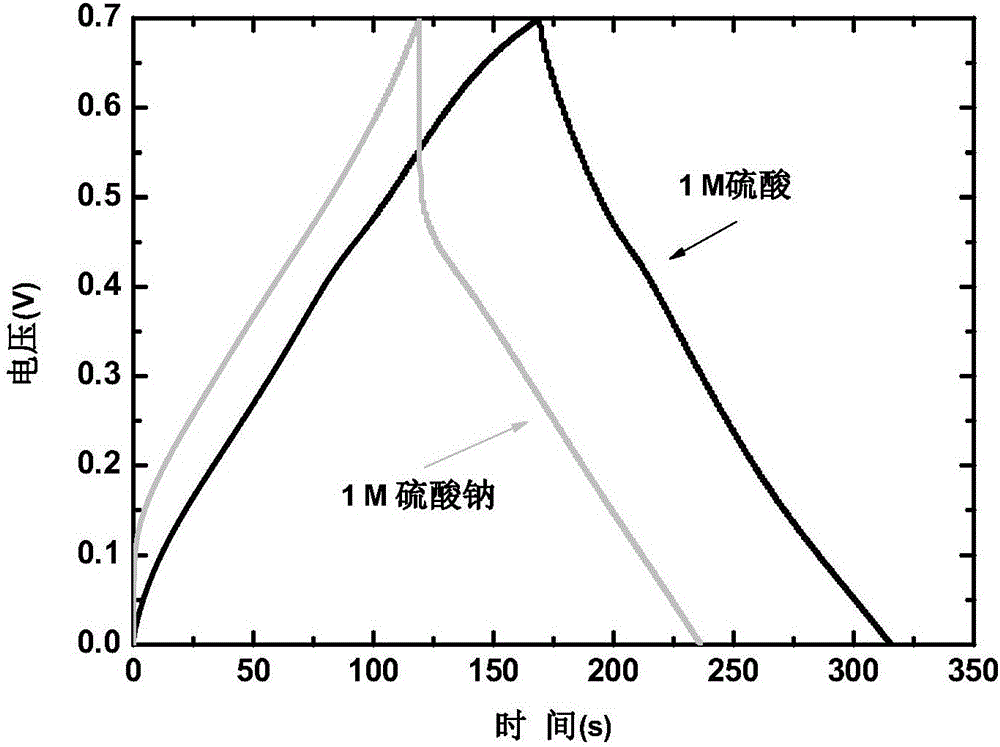Three asymmetric solid-state electrochemical capacitors constructed through nanometer copolyaniline and activated carbon
A technology of copolyaniline and activated carbon, applied in the direction of hybrid capacitor electrodes, etc., to ensure the effect of cycle stability and high-quality specific capacitance
- Summary
- Abstract
- Description
- Claims
- Application Information
AI Technical Summary
Problems solved by technology
Method used
Image
Examples
Embodiment 1
[0049] Example 1: Preparation of positive and negative electrodes with matching loading
[0050] Preparation of positive electrode dispersion: Put sulfonated copolyaniline, conductive agent carbon black and binder N-ethylaniline / aniline copolymer in a ball mill at a weight ratio of 80 / 10 / 10, and add an appropriate amount of 1-methyl-2-pyrrolidone After grinding, ultrasonic dispersion is carried out, and a blended dispersion with a weight concentration of about 2 wt% is prepared for use.
[0051] Preparation of negative electrode dispersion: mix the activated carbon, conductive carbon black and the binder SBR and CMC in a weight ratio of 80 / 10 / 6 / 4, add an appropriate amount of high-purity water and stir vigorously for 3 hours to prepare a 2wt% blended dispersion for use.
[0052] The effective area of cut 316L stainless steel mesh is 1×1cm 2 After cleaning, insert the positive electrode and negative electrode dispersion liquids into the square grids. After being coated with a certa...
Embodiment 2
[0060] Example 2: Construction and electrochemical performance of three asymmetric supercapacitors
[0061] Add 1g of concentrated sulfuric acid (98% by volume) and 1g of PVA to 10ml of deionized water, stir and dissolve vigorously at 90℃ for 1h to obtain PVA-H 2 SO 4 The gel is ready for use. Similarly, 1g of sodium sulfate powder and 1g of CMC are added to 10ml of deionized water, and the solution is stirred vigorously at 90℃ for 1h to obtain CMC-Na 2 SO 4 The gel is ready for use. The sulfonated copolyaniline cathode in Example 1 is immersed in PVA-H 2 SO 4 Gel, activated carbon negative electrode immersed in CMC-Na 2 SO 4 Gel, soak for 15 minutes to make the electrode material fully infiltrated, and at the same time the cellulose membrane is in 1M Na 2 SO 4 Soak in the solution for 15 minutes. Then, the positive electrode impregnated with electrolyte gel, the cellulose separator and the negative electrode impregnated with another electrolyte gel are stacked together in order ...
Embodiment 3
[0070] Example 3: Ragone curve of three asymmetric supercapacitors
[0071] In order to investigate the rate performance of the three asymmetric supercapacitors, the three asymmetric supercapacitors in Example 2 were tested by changing the current density under four potential windows to test their CC charging and discharging performance, and the CC charging and discharging performance was tested by formula (3)--( 5) Calculate the energy density and power density, and plot the power density as the abscissa and the energy density as the ordinate to obtain 4 Ragone curves under 4 potential windows. See details Figure 8 . It can be seen that under the fixed potential window, increasing the current density, the power density obviously increases, while the energy density is slightly reduced, indicating that the three asymmetric supercapacitors have better rate performance.
PUM
| Property | Measurement | Unit |
|---|---|---|
| Specific capacitance | aaaaa | aaaaa |
Abstract
Description
Claims
Application Information
 Login to View More
Login to View More - R&D
- Intellectual Property
- Life Sciences
- Materials
- Tech Scout
- Unparalleled Data Quality
- Higher Quality Content
- 60% Fewer Hallucinations
Browse by: Latest US Patents, China's latest patents, Technical Efficacy Thesaurus, Application Domain, Technology Topic, Popular Technical Reports.
© 2025 PatSnap. All rights reserved.Legal|Privacy policy|Modern Slavery Act Transparency Statement|Sitemap|About US| Contact US: help@patsnap.com



